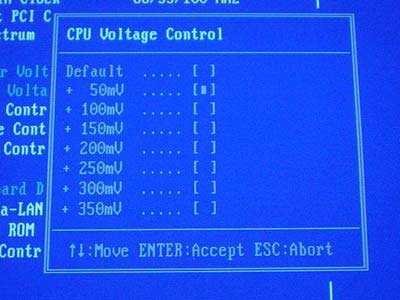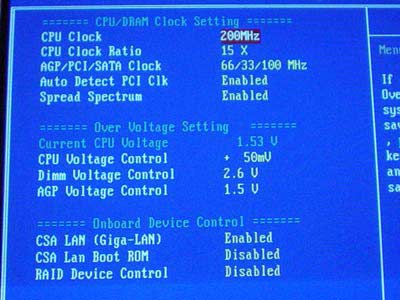865PE/875P Motherboard Roundup June 2003 - Part 1: 20-way Shootout
by Evan Lieb on June 12, 2003 10:57 PM EST- Posted in
- Motherboards
DFI PRO875: Basic Features
|
Motherboard Specifications |
|
|
CPU
Interface
|
Socket-478
|
|
Chipset
|
Intel
82875P MCH (North Bridge)
Intel 82801ER ICH5R (South Bridge) |
|
Bus
Speeds
|
up
to 400MHz (in 1MHz increments)
|
|
Core
Voltages Supported
|
up
to 1.85V (in 0.050V increments)
|
|
I/O
Voltages Supported
|
N/A
|
|
DRAM
Voltages Supported
|
up
to 2.7V (in 0.1V increments)
|
|
Memory Slots
|
4 184-pin
DDR DIMM Slots
|
|
Expansion Slots
|
1 AGP
8X Slot
5 PCI Slots |
|
Onboard IDE RAID
|
HighPoint
HPT372 ATA133 Controller
|
|
Onboard USB 2.0/IEEE-1394
|
Eight
USB 2.0 ports supported through South Bridge
No Firewire |
|
Onboard LAN
|
Intel
PRO/1000CT Gigabit LAN (CSA bus)
|
|
Onboard Audio
|
C-Media
CMI9739A codec
|
|
Onboard Serial ATA
|
Two
SATA connectors via ICH5R (RAID 0 & RAID 1 only)
|
|
BIOS
Revision
|
5/16/2003
BIOS date
|

A nice touch to the PRO875 is its HighPoint HPT372 controller for onboard IDE RAID, capable of RAID 0, 1, and 0 + 1 support. This ATA133 complaint controller is capable of supporting up to two IDE drives via the two orange IDE connectors located at the bottom of the motherboard. In combination with the Primary and Secondary IDE connectors, two Serial ATA connectors, and the two HighPoint RAID connectors the PRO875 is capable of supporting up to a total of ten IDE drives.
What truly separates the PRO875 from most other P4 motherboards is its bundle
of accessories. The most interesting accessory included with the PRO875 is the
PC Transpo, which is essentially a light backpack for carrying your tower around,
mostly to LAN parties (hence the reason DFI is marketing the PRO875 as a "LAN
Party" motherboard). This backpack is a very nice feature to have if you're
someone who travels a lot and doesn't want to sacrifice any performance like
you would have to by carrying a laptop around. This is truer for gamers more
than any other audience, especially when you consider the fact that there isn't
a single laptop in existence that is powered by a DX9 GPU. Of course, if you're
not really a hardcore gamer and can't stand lugging around your tower in a backpack,
the PC Transpo probably isn't for you.
Another accessory included with the PRO875 is a FrontX panel which includes
two USB 2.0 ports and two audio ports for sound. DFI also includes a two-port
USB 2.0 bracket to round out the eight possible USB 2.0 ports you can use with
the PRO875. FrontX is an excellent addition to the PRO875's accessory package
as it is convenient for those that don't like to hook up their USB and/or audio
devices to the back of their tower.
Another interesting "feature" the PRO875 brings to the table is its UV sensitive components, such as the PCI slots and IDE connectors. Install this motherboard into a good see-through computer case and place a black light inside and you've got a glow-in-the-dark machine lighting up your room. This glow-in-the-dark feature is especially handy if you're afraid of the dark.

The most notable BIOS options the PRO875 contains is Vcore, which is available up to 1.85V in 0.050V increments. Though the increments in which you are able to adjust Vcore aren't as fine as most motherboard's BIOSes (usually 0.0250V, sometimes lower), 1.85V is still an excellent Vcore maximum for this type of motherboard. It doesn't matter that the PRO875 undervolts to 1.48V or so with the 2.4C processor we used, as you'll still be able to get well over 1.80V anyway. This high of a Vcore is not at all necessary unless you're simply going for an overclocking/performance record in 3DMark or something like that, so we suggest you stray no higher than a 1.70V maximum if you want to push your CPU and motherboard to the limit without scrapping them within a matter or weeks or a couple of months.

There are only a few negative things worth pointing out about the PRO875. Firstly the odd positioning of the Floppy connector will cause problems for users that intend to use the onboard IDE RAID. Reducing case clutter will be difficult with a Floppy drive installed along with any drives attached to the IDE RAID connectors at the bottom of the PCB. It would have been nice to have added some IEEE 1394 FireWire to the mix as well, but since USB is much more widely used (even among enthusiasts and gamers) we can understand DFI's decision. Only a niche segment of the market will be disappointed that the PRO875 lacks any PCI FireWire.










18 Comments
View All Comments
Zak - Sunday, January 18, 2004 - link
I bought IS7 after reading this article and I've been having problems. Random resets, then BSOD after changing XP recovery settings. Over the past few months it worsened. In the begining it like once a week maybe. I wasn't concerned, bad driver I thought. Now it won't run more than an hour without BSOD. I have Corsair XMS DDR400 in it. I've played with memory settings for weeks, timings and voltages as well, reinstalled XPPro several times, updated BIOS, got all newest drivers and run out of ideas... I've put a stick of DDR333 because that's all have to test and I still get the same random BSOD, even durnig XP installation. I have no PCI cards in this box. Mushkin calls this board problematic and attributes the memory problems to forced implementation of PAT that is not normally present in 865. I may try getting it replaced by NewEgg but I don't suppose it'll help. I'm thinking about getting a 875 board instead. Zak.Anonymous User - Friday, October 24, 2003 - link
I would like to see part II of the roundup of the 865 chipset. I wonder what is the delay?Anonymous User - Monday, October 13, 2003 - link
I thought Part 2 would be out by now at least... There are good new boards out there I'd like to see... Shuttle AB60R (cheap and full featured) and Abit IC7-MAX3 (OTES for mobo power area). I am still looking forward to seeing this, eventually, right guys?Anonymous User - Tuesday, October 7, 2003 - link
Any comments on newer motherboards? Why hasn't supermicro been tested since 2000?Looking to compare supermicro
Intel s875wp1-e and Super P4SCE (SuperServer 5013C-I (SYS-5013-CI)) for a $50k cluster
Thanks
syzygyus@yahoo.com
Anonymous User - Friday, August 29, 2003 - link
Evan, how in the world is #4 going to research your statement when the articles/review comments forum gets purged/is gone now ?Anonymous User - Saturday, August 23, 2003 - link
Any word on Revision 2 of the Gigabyte 8knxp ultra board yet?Anonymous User - Sunday, August 10, 2003 - link
I bought the is7 after I read this article. It had many problems. I ended up having to ram this board twice. If you read the abit forum boards you will see alot of problems I am fairly surprised after all the tests this board was put through nothing ever went wrong. I will not buy another abit product period. I will stick to gigabye i've built 6 systems with Gigabyte and yet to have any problems with them. Save for the chipset fans having a low life.Anonymous User - Friday, August 8, 2003 - link
I bought the Abit IS7 and am completely pleased. One note is that many of the IS7's appear to be getting shipped with the gigabit lan as opposed to the sales brochure stated 10/100. (mine has the gigabit)Anonymous User - Tuesday, August 5, 2003 - link
How could it be that the Asus p4c 800 de luxe is more expensive then the asus p4p deluxe but in the testresults it is slower?I would think i am misinformed by the computershop?
And the p4c deluxe got a gigabit lan on board, despite mentioning in the summary of this Mb it has not.
PixelDoc - Sunday, July 27, 2003 - link
Error Re: Gigabyte GA-8KNXP MoBoThis MoBo has 4, not 2 SATA connectors, 2 controlled by ICH5R and 2 more contolled by the SIL3112 chip.